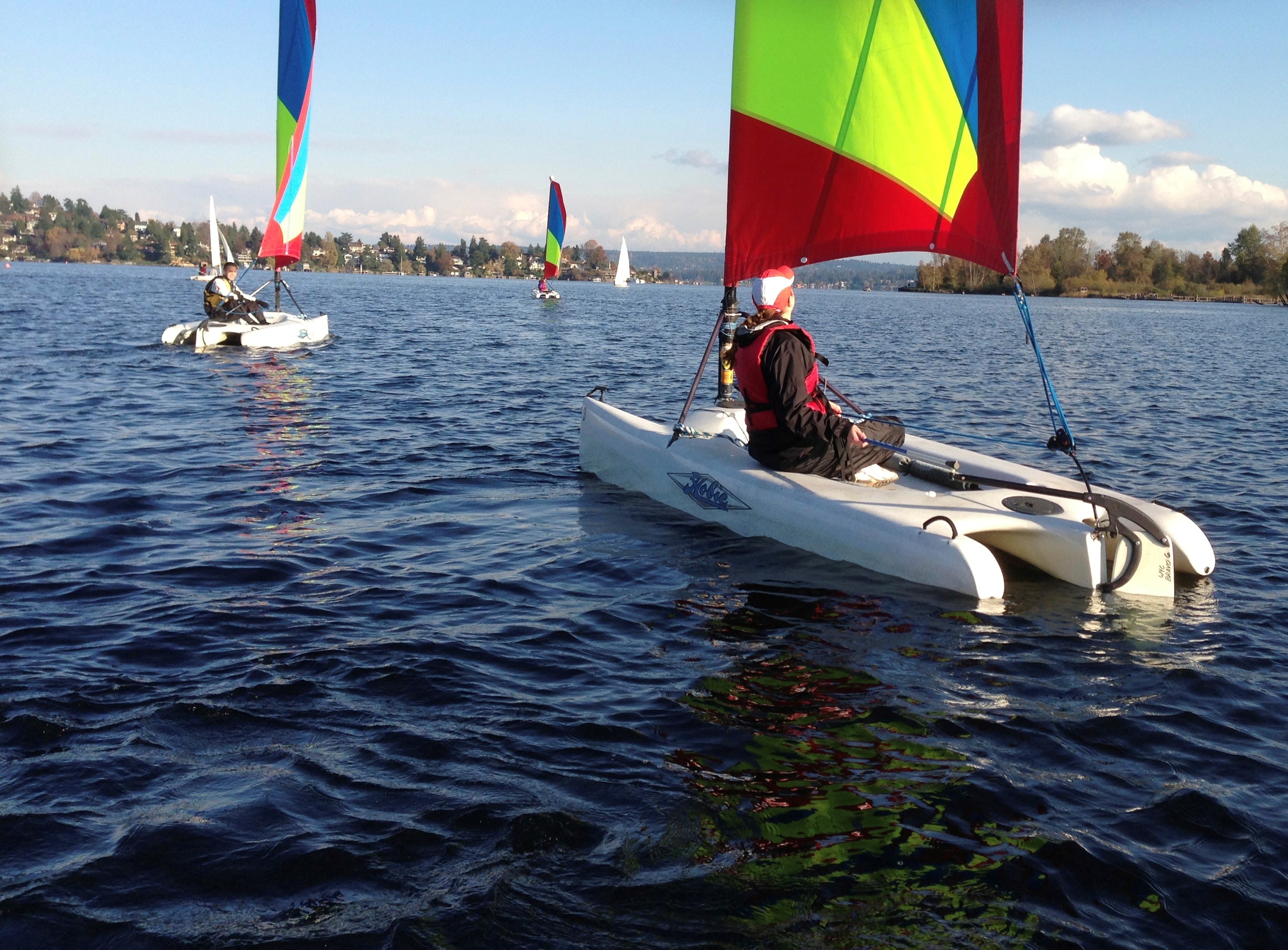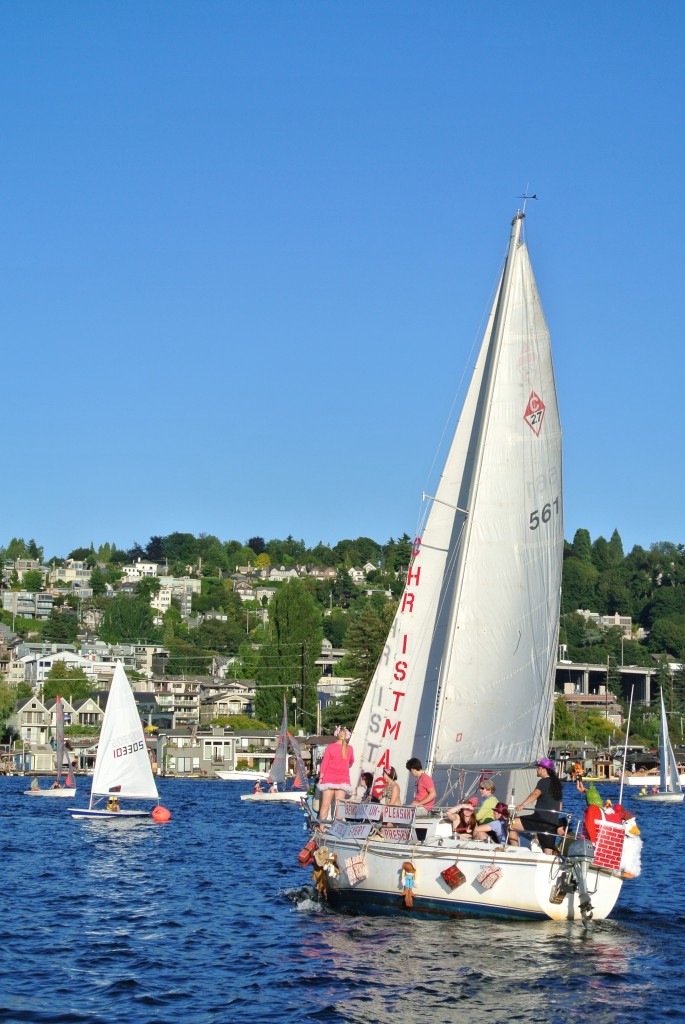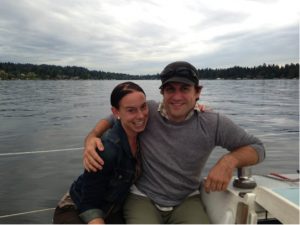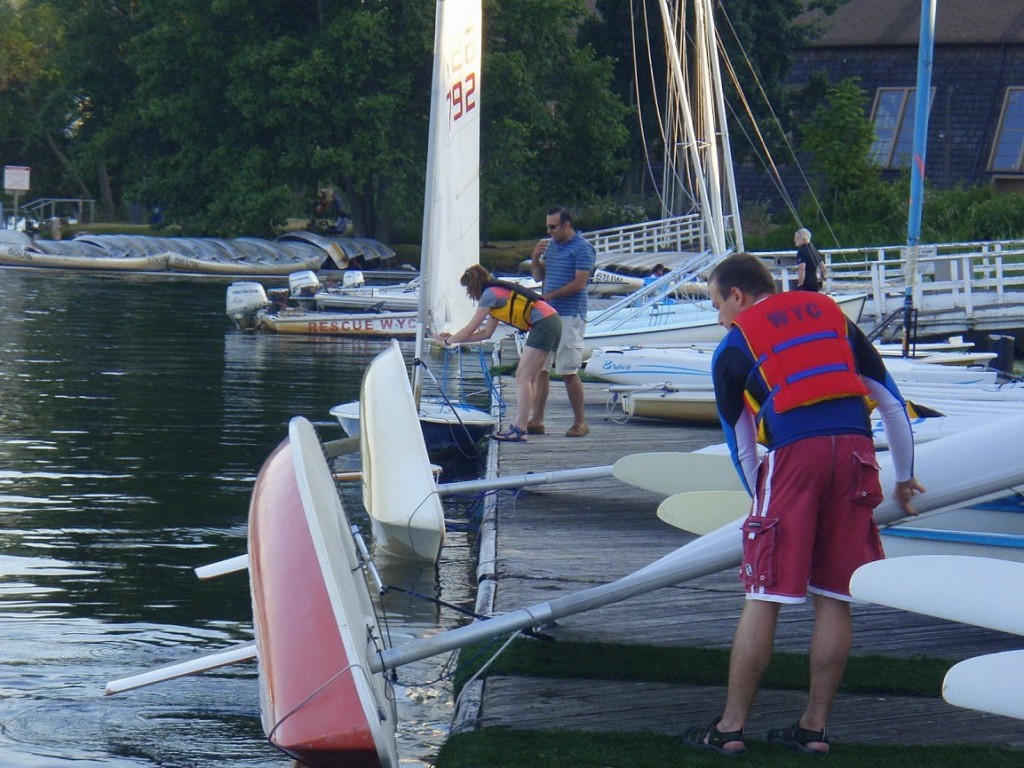
Perk Spotlight: Learning to Sail at UW
I promised my husband sailing lessons for Christmas of 2010. But as we delved into the logistics, one thing popped up after another: “The lessons cost HOW much?”…”You mean that’s the rental cost for one day, not one week?!”… “So you can buy an old boat on the cheap—and then store it where?”… And more importantly: “Just how are we supposed to know that said boat is not going to sink on us?” Needless to say, the Christmas wish remained just that.
When I joined UW the following year, I knew I had landed a job with excellent perks. Little did I know they would eventually land me in a sailboat. As staff, my husband and I are eligible to join the Washington Yacht Club (WYC), which is a UW student-run organization that owns a fleet of boats at the Waterfront Activities Center and offers a large variety of sailing lessons, socials, and competitive racing opportunities. By paying either a quarterly or annual membership fee, one is immediately permitted to use certain beginner boats during supervised sailing hours. In order to use boats outside of supervised sailing hours, members may take a range of lessons and work their way up from a small dinghy to a 30 foot keelboat by passing sequential ratings tests. Most boats are free, and daily keelboat rentals are incredibly affordable at just $40 a day.
But first, we needed to learn to sail. As I signed my husband and I up for double-handed (read: two person dinghy) sailing lessons, the friendly instructor, half kidding and perhaps half not, said “You

WYC members and friends aboard a WYC keelboat at the “Duck Dodge”, a sailing race held weekly on Lake Union. Instructor Ken Howe has decorated the boat with a “Christmas In July” theme.
know, we usually recommend that married couples get in different boats.” And that was my first warning: this is going to be an adventure.
As the first day of lessons approached, my excitement subsided and self-doubt began creeping in. How could I ever learn to move a huge apparatus over deep waters when moving a huge apparatus across solid ground—a.k.a. driving– is not exactly my strong suit? As much as I tried to think positive while studying the assigned materials, I was visited by visions of myself tipping the boat, husband and I plunging into frigid waters, instructors’ admonitions confirmed by resulting marital strife.
Day one arrives. It’s gray, it’s chilly, it’s super windy. Seattle is not helping me out here. I prepare as though I’m going ice-fishing in the Antarctic: layers of water-resistant clothing, wetsuit, calorie dense snacks, fleece galore. Our class of two instructors and eleven students meets in the equipment room to talk through materials. The room is crammed with stuff, but check-out is easy and we’re finished in mere minutes. Step one survived. We then head to the repair room where old chairs and a dry erase board form a makeshift classroom. Our good-natured instructor reviews the basics of double-handed sailing and has us practice steering on a model tiller. Thank goodness he had prompted us to study beforehand, as this is an overview. The classroom portion ends and I conclude I still have much to learn about novice sailing, but am assured it will start coming together once we’re actually in a boat.
We head to the dock and learn to rig our boats. I start to get a little excited when our sails raise without struggle. However, the winds are strong—too strong for a novice—but we’re soon taking turns sailing the small boats with the skillful and chipper assistant instructor. He shows me how to control the smaller sail. We don’t tip (!). I am dry (!). Suddenly, I notice the sun is shining. Stand-up-paddleboarders, canoers, and boaters of all sorts energize the atmosphere and enliven the beautiful backdrop of Union Bay. I may not be able to sail on my own yet, but I begin to feel capable, and allow myself a quiet moment of triumph at having overcome my self-doubt. The lesson ends early on account of the gusts and the instructor kindly offers to take us out for a keelboat trip. We return the next day, where we master the art of capsizing. This is a good thing, as it is under the watchful eye of the instructor who coaches us from the WYC rescue boat. In the process, I learn why they call the boom the boom (careful!). However, the July waters are refreshing and I’m happy with our progress. All in all, my peers and I pass certain sections of the novice level rating, but the winds do not allow us to pass the maneuverability skills. The instructors encourage us to return to supervised sailing hours to practice and complete our rating, and we are eager to keep up the momentum.
Although sailing a yacht still seems a long way off, I have concluded that the Washington Yacht Club is my kind of sailing club. The People’s Yacht Club, if you will. No elitism here, only practical guidance in a supportive, down-to-earth environment. The rates are remarkably affordable relative to other sailing lessons and clubs in the area. Unlike private companies, the club is student-run and lessons are led by volunteer instructors. Although experiences are likely to vary accordingly, my instructor is a devoted and experienced retiree and his assistant a recently trained student, forming a complementary duo who are easygoing and enthusiastic in a way that only volunteers can be. Given that learning to sail is a weather-dependent activity, the open invitation to return for regular practice is key. For example, although none in my group were able to pass the maneuvering skills, in the following weekend the entire class passed as the winds were ideal. That we are entitled to boat-borrowing privileges seems a critical yet exceptional luxury of membership, one that presumably would not apply had we only taken one-time sailing lessons elsewhere. Maintenance of the myriad boats, many of them quite old, is done exclusively by members and volunteers at weekly work parties, with a requirement to attend one per quarter. Like I said, the People’s Yacht Club.
At the end of the day, I know it will take perseverance, time, and a commitment to the responsibilities of membership to get to the end-goal of taking the keelboats out on day or overnight trips, but with novice lessons behind me and membership privileges before me, I begin to believe again in the Christmas wish of old.
Cost Comparison for Novice Sailing Lessons*
| Washington Yacht Club (UW) | Free w/ membership ($75/qtr + $45 initiation fee for faculty/staff) |
| Seattle Sailing Club | $325 Member, $525 Non-Member |
| Seattle Yacht Club | $225 Member, $275 Non-Member |
| Center for Wooden Boats | $340 Member, $400 Non-Member |
*This is a surface-level cost-comparison of introductory sailing lessons for adult beginners, and does not take into account the specifics of the lessons.
 Anne and her husband aboard a Washington Yacht Club Keelboat on Union Bay last fall. Anne is a Fitness Coordinator for the Department of Recreational Sports Programs, as well as an aspiring skipper.
Anne and her husband aboard a Washington Yacht Club Keelboat on Union Bay last fall. Anne is a Fitness Coordinator for the Department of Recreational Sports Programs, as well as an aspiring skipper.

2 Thoughts on “Perk Spotlight: Learning to Sail at UW”
On August 13, 2014 at 6:45 AM, Lyle Larson said:
I’m so glad I saw this! This is precisely what I’ve been looking for. Thank you MY UW for an inspiring (and informative) article.
On August 13, 2014 at 6:46 AM, Lyle Larson said:
Oops” Should have said The Whole U and not MY UW!!
Comments are closed.